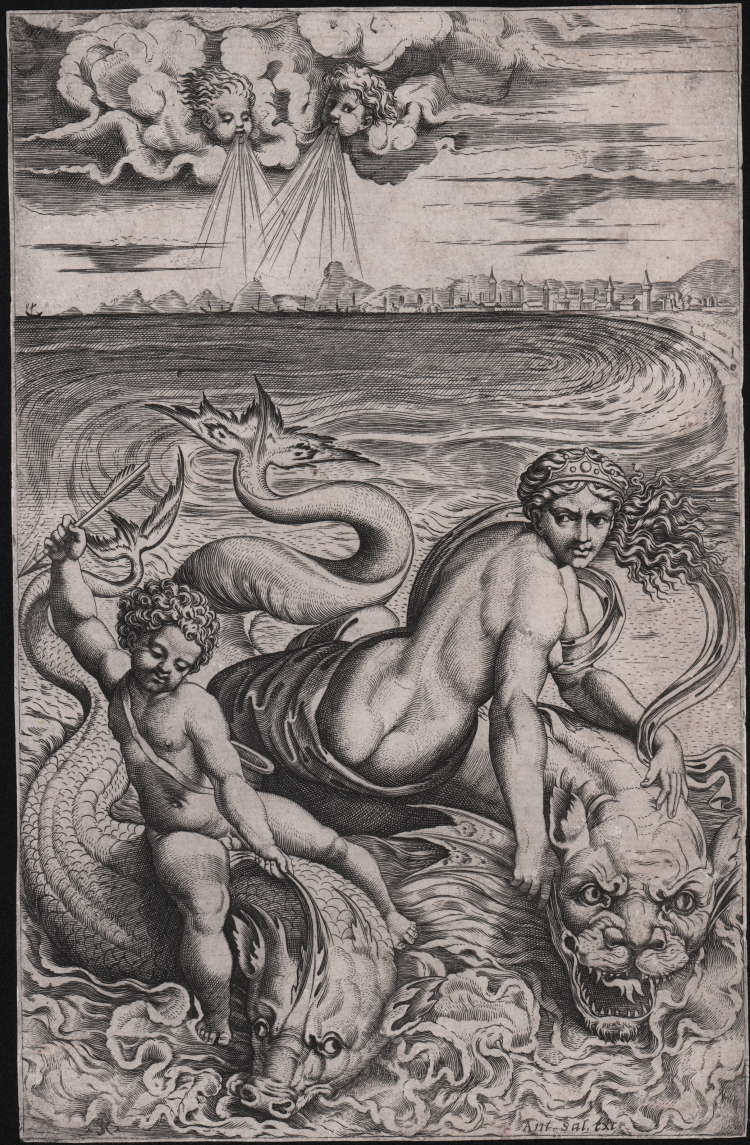




| Reference: | S46558 |
| Author | Marco DENTE detto "Marco da Ravenna" |
| Year: | 1516 ca. |
| Measures: | 170 x 265 mm |



| Reference: | S46558 |
| Author | Marco DENTE detto "Marco da Ravenna" |
| Year: | 1516 ca. |
| Measures: | 170 x 265 mm |
Venus and Cupid riding on the backs of two sea creatures (dolphins?); Cupid holding a arrow above his head in his right hand as if to strike the creature; two personifications of winds blowing in the clouds above.
Engraving, 1516 circa, lettered bottom right 'Ant. Sal. exc.'.
After Raphael's design, now lost, for Giulio Romano's fresco on the south wall of the Stufetta Bibbiena at the Vatican. There are differences between the fresco and engraving, namely in the addition of a cityscape in the background of the print and the two winds above which may have been included in the original preparatory drawing for the fresco.
Example of the second state of three, with the Antonio Salamanca imprint and before the Guidetti address.
A fine, early, impression, on contemporary laid paper, trimmed to the platemark, perfectly executed restorations at corners, otherwise in excellent condition.
The depiction of Venus and Cupid plowing through the waves riding dolphins has a compositional structure reminiscent of the Venus Anadiomene, also derived by Dente from a preparatory drawing for another fresco in Cardinal Bibbiena's Stufetta, and of which this print can be considered the pendant. The individual motifs in the engraving are probably derived from ancient bas-reliefs found in Roman sarcophagi. In fact, the engraver draws from the classical repertoire by deriving from the heroes present in the ancient reliefs the figure of Cupid attempting to hasten his journey on the back of a dolphin by waving an arrow in the air. The sea monsters, on the other hand, seem to derive from Mantegna's Struggle of the Sea Gods (Bartsch, XII, 17-18). The figure of Venus, though caught from the back and in the precariousness of her position, is also inspired by classical models. The body is accurately rendered and reveals, despite the boldness of the foreshortening and the oblique position relative to the surface of the water, a perfect organicity and a great naturalness of movement in space. The modeling of the body of Venus, even more than with the Galatea of the Farnesina, engraved by both Marcantonio and Dente (Bartsch, XIV, 350 and 351), can be compared with Raphael's drawings Hebe and Proserpine of Haarlem and with the Three Graces of Windsor. On the basis of these arguments it is possible to assume that the preparatory drawing for this engraving was the work of Raphael and that the print is contemporary with the other depictions in the series relating to the Stufetta frescoes, which can be dated to around 1516.
Bibliografia
Passavant, 1860, II, p. 230, 210; Bianchi, 1968, p. 685, nota 219; Becatti, 1968, p. 546, fig. 106; Ober- huber, 1978, vol. 27, p. 16; Rafael invenit, 1985, pp. 61, n. II.1 (testo di S. Massari); Raffaello in Va- ticano, 1984, p. 205, n. 75 (testo di R. Harpath); Oberhuber, Gnann, 1999, p. 105, fig. 44 (testo di A. Gnann); A. Imolesi Pozzi, Marco Dente un incisore ravennate nel segno di Raffaello. Le stampe della raccolta Piancastelli, p. 72, n. 10.
Marco DENTE detto "Marco da Ravenna" (Ravenna 1496 - Roma 1527)
|
The right name of this artist was Marco from Ravenna, not Silvestro as erroneously many people say due to the monogram RS, which has to be interpreted as ravenates sculpsit or sculptor. He came from a rich family of Ravenna, where he was born in 1493; he afterwards died in the Sack of Rome in 1527, as Zani says.
He went to Rome very likely in 1510 to work inside Baviera’s workshop, together with Marcantonio and Agostino Veneziano. In Rome, the artist from Ravenna, besides engraving the most beautuful examples of classical statuary, mainly devouted himself to the reproduction of Raphael’s drawings, as his collegue Raimondi.
Marco can be condidered a very uncommon artist, for he was the first to renew the school of Marcantonio, with “fully pictorial” prints.
Bartsch ascribes to him sixtytwo subjects, while Passavant says are sixtyfour.
|
Marco DENTE detto "Marco da Ravenna" (Ravenna 1496 - Roma 1527)
|
The right name of this artist was Marco from Ravenna, not Silvestro as erroneously many people say due to the monogram RS, which has to be interpreted as ravenates sculpsit or sculptor. He came from a rich family of Ravenna, where he was born in 1493; he afterwards died in the Sack of Rome in 1527, as Zani says.
He went to Rome very likely in 1510 to work inside Baviera’s workshop, together with Marcantonio and Agostino Veneziano. In Rome, the artist from Ravenna, besides engraving the most beautuful examples of classical statuary, mainly devouted himself to the reproduction of Raphael’s drawings, as his collegue Raimondi.
Marco can be condidered a very uncommon artist, for he was the first to renew the school of Marcantonio, with “fully pictorial” prints.
Bartsch ascribes to him sixtytwo subjects, while Passavant says are sixtyfour.
|